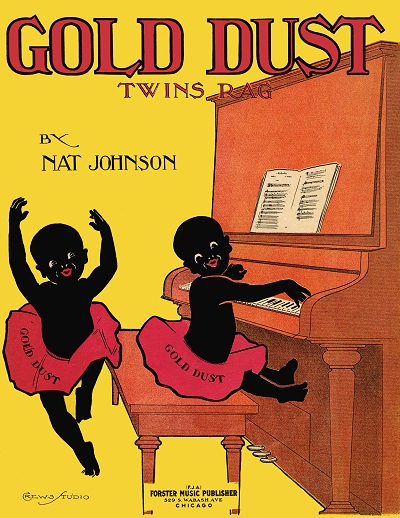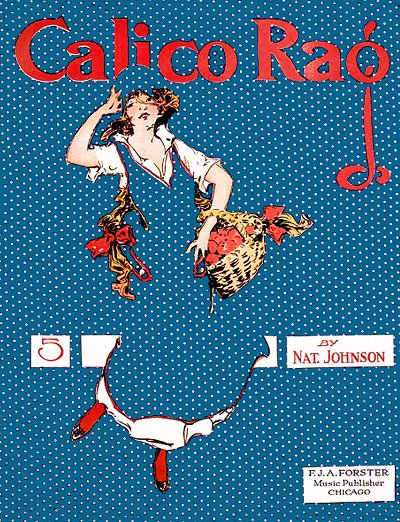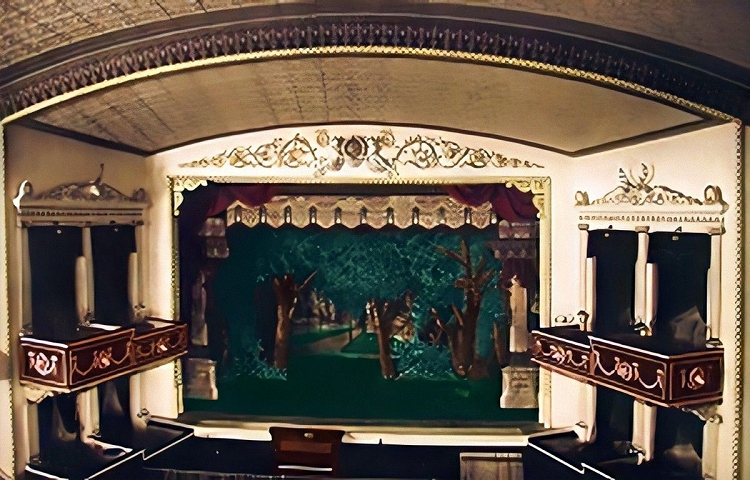|
Nathan Henry "Nat" Johnson (December 15, 1883 to November 22, 1921) | |
 Compositions and Rollography Compositions and Rollography | |
|
1911
Nat Johnson's Rag1912
Frisco FrazzleSociety Rag Sun Kissed Roses: Waltzes Lovey Moon [1] 1913
Gold Dust Twins RagO.P.H.S. Rag [2] 1914
Dance of the Flowers (Pas de Fleurs)Wild Roses: Valse Brilliante Calico Rag Hesitation Waltz 1915
Helendoro: Fox Trot Rag [U.S. Music 7269]Helendoro Waltzes [U.S. Music 7288] Dorothy Rag [U.S. Music 7289] |
1915 (Cont)
Country Capers: Barn Dance [U.S. Music 7428]When You're Away I'm Lonely [3] 1917
Georgia Sweets [U.S. Music 8249]Caterpillar Creep [U.S. Music ?] 1918
Banner of Victory: March1920
If You'll Come Back [4]1921
Dinah [Mentioned in obituary]1924 (Posth)
Whose Wonderful Daddy are You? [3]
1. w/Charles W. Dingle
2. w/Will Mack 3. w/James Royce Shannon 4. w/Rene Taylor |
Nathan Johnson was born in Boston, Massachusetts to Swedish parents Bernhard Francis Johnson and Matilda Kulberg. His parents had both immigrated to the United States in the 1870s. The transcription of Nathan's birth record shows a year of 1883, but all subsequent records, including Nathan's draft card, seem to indicate an 1882 birth year. Little is known of his education, but much of it was likely in the Boston school system, and perhaps he was either self-taught on piano or may have received some private lessons at some point. His father, listed in the Boston city directory in 1883 as a sextant (likely intended as "sexton," which is a church or synagogue officer responsible for building maintenance), was working as a janitor over the next several years, so income for the family was low. To add to their difficulties, Matilda died in 1889. While Bernhard appears in the 1900 census in Everett, a northern suburb of Boston, efforts to find Nathan that year turned up nothing definitive, as he had likely struck out on his own after his mother's death.
His father, listed in the Boston city directory in 1883 as a sextant (likely intended as "sexton," which is a church or synagogue officer responsible for building maintenance), was working as a janitor over the next several years, so income for the family was low. To add to their difficulties, Matilda died in 1889. While Bernhard appears in the 1900 census in Everett, a northern suburb of Boston, efforts to find Nathan that year turned up nothing definitive, as he had likely struck out on his own after his mother's death.
 His father, listed in the Boston city directory in 1883 as a sextant (likely intended as "sexton," which is a church or synagogue officer responsible for building maintenance), was working as a janitor over the next several years, so income for the family was low. To add to their difficulties, Matilda died in 1889. While Bernhard appears in the 1900 census in Everett, a northern suburb of Boston, efforts to find Nathan that year turned up nothing definitive, as he had likely struck out on his own after his mother's death.
His father, listed in the Boston city directory in 1883 as a sextant (likely intended as "sexton," which is a church or synagogue officer responsible for building maintenance), was working as a janitor over the next several years, so income for the family was low. To add to their difficulties, Matilda died in 1889. While Bernhard appears in the 1900 census in Everett, a northern suburb of Boston, efforts to find Nathan that year turned up nothing definitive, as he had likely struck out on his own after his mother's death.In June 1902 Bernhard was remarried to Elsa B. Strandman, who like her predecessor was also a Swedish immigrant. Nathan was found living in nearby Beverly, Massachusetts that same year, still there in 1904. He eventually moved back in with his father and was living with the couple around 1910. Nathan had already clearly made music his career, listed as a pianist for a theatrical company in the 1910 enumeration. It is known from later articles that he toured for a few years with various vaudeville companies. Starting in 1911 he had some of his music published, starting with Nat Johnson's Rag. The following year produced the dynamic Frisco Frazzle, and a year later he wrote the Gold Dust Twins Rag, which was essentially a syncopated advertisement for the famous Gold Dust brand of laundry soap which featured the Gold Dust Twins (two little black boys) on the box. They also appeared on the sheet music cover, making this one of the more unusual commercial jingles in American history. In his travels Nat went through and likely stayed in Chicago now and then. The fact that his pieces were primarily published by the Forster firm, which was based in Chicago, provides some information to that effect.
To further codify Johnson's Chicago connection, one of his pieces published in 1913, O.P.H.S. Rag, composed with lyricist Will Mack, was reportedly for or about Oak Park High School in Chicago. The school had been established in 1871 just after the great Chicago fire, and was relocated in 1907 to a better location. Researcher and performer Andrew Barrett indicates that there was at least some possible motive, based on a competition called The National High School Football National Championship. It was not a real game, but a poll among sportswriters and other journalists. The song takes this competition with Everett High School in Johnson's native Massachusetts, and lyrically makes it into a real game. This self-published rag had very limited circulation.
The school had been established in 1871 just after the great Chicago fire, and was relocated in 1907 to a better location. Researcher and performer Andrew Barrett indicates that there was at least some possible motive, based on a competition called The National High School Football National Championship. It was not a real game, but a poll among sportswriters and other journalists. The song takes this competition with Everett High School in Johnson's native Massachusetts, and lyrically makes it into a real game. This self-published rag had very limited circulation.
 The school had been established in 1871 just after the great Chicago fire, and was relocated in 1907 to a better location. Researcher and performer Andrew Barrett indicates that there was at least some possible motive, based on a competition called The National High School Football National Championship. It was not a real game, but a poll among sportswriters and other journalists. The song takes this competition with Everett High School in Johnson's native Massachusetts, and lyrically makes it into a real game. This self-published rag had very limited circulation.
The school had been established in 1871 just after the great Chicago fire, and was relocated in 1907 to a better location. Researcher and performer Andrew Barrett indicates that there was at least some possible motive, based on a competition called The National High School Football National Championship. It was not a real game, but a poll among sportswriters and other journalists. The song takes this competition with Everett High School in Johnson's native Massachusetts, and lyrically makes it into a real game. This self-published rag had very limited circulation.Calico Rag from 1914 is perhaps the best-known Nat Johnson piece. Made up largely of arpeggios, it still presents very well. There were three, or perhaps even four remaining pieces that were committed to piano rolls in the mid-1910s. One of them, Helendoro: The Fox Trot Rag, is a fox trot that appears to have had an accompanying waltz associated with it. They are two separate works with some possible thematic tie-ins, but none that are overtly evident. Both show up on rolls from U.S. Music in early 1915. Who or what Helendoro is remains a mystery. While Johnson was shown in copyright records as having composed these pieces in addition to Georgia Sweets and Dorothy Rag, there is speculation on whether he actually played them, perhaps during one of his Chicago visits. However, they were more likely simply arranged for rolls from original manuscripts, given the manner in which they were highlighted in the May 8, 1915 issue of the Music Trade Review:
The May bulletin of the United States Music Co. lists three numbers which promise to have an exceptional sale. They are exclusive to the United States Co. who own the manuscript which they purchased for the single purpose of issuing in music roll form, a habit, by the way, which this company has cultivated for some years past. The three numbers referred to are all by Nat Johnson, the composer of the Gold Dust Rag, the Calico Rag, etc. The Helendora [sic] Waltzes have an enticing, dreamy theme which one instinctively wants to sing, followed by a quick movement on the Spanish order. The Helendora [sic] Fox Trot Rag is an unusually melodious whistliferous and feetcompelling proposition which should prove immensely popular. Dorothy Rag will no doubt rank exceedingly high in its class.
In the mid-1910s Nat decided to scope out the wild west, and ended up in Prescott Arizona, spending some time in New Mexico as well. Researcher and trombonist David Sager of the Library of Congress found a copyright for a Johnson composition titled Caterpillar Walk from 1917, registered in Silver City, New Mexico.
However, the official Library of Congress record shows Caterpillar Creep, also in 1917, which listed Everett, Massachusetts as his registered address. Whether or not these are two different works is as yet unclear, as Caterpillar Walk has not surfaced. Efforts are underway to find a possible published copy or manuscript of this piece or the roll of Caterpillar Creep played by composer/performer Paul Pratt and his partner Mary E. "Mae" Brown.
 |
Johnson was next found in Prescott according to his 1918 draft record, listing himself as a musician playing for the grand 900 seat Elks Theater of Yavapai County, also in Prescott. It was one of the technological showplaces of the southwest, and run by the Prescott Benevolent Protected Order of Elks (BPOE). The 1920 census showed Nat in Silver City in the neighboring state of New Mexico. Two pieces of music published there, including lyrics by Rene Taylor, also confirm his presence. He also had been involved in the production of some musical comedies in Silver City, including one titled Over the Top which reportedly incorporated some of his own compositions.
Johnson had contracted pulmonary tuberculosis somewhere along the way, and by mid-1920 he was staying at the Cottage Sanatorium in Silver City. Also with him was Miss Rene Taylor, with whom Nat wrote at least two songs. According to a letter discovered by researcher Mike Montgomery, in an effort to defer expenses at the sanatorium, Johnson wrote to the Edison Phonograph Company offering up his new song, If You'll Come Back, to them for recording. Nothing came from that effort, and the TB took his life within eighteen months. An obituary uncovered by Barrett lauded his performance skills, stating that "He seemed to be able to do anything with a piano but make it talk English." Nat Johnson currently occupies an unmarked grave in the Masonic Cemetery in Silver City. Mr. Barrett worked to rectify that by getting Nat proper recognition at his actual grave site.
Thanks go to Southern California ragtime/novelty performer Andrew Barrett who researched some of the details on Johnson, including his birth and death records, and the piano roll information. His input was invaluable for this account of Johnson's life. He was helped by Susan Berry of the Silver City Museum in Silver City, New Mexico. Some additional bits of information came from researcher and author Trebor Tichenor. The remaining core of information was from the author's own research in music archives, newspapers and public records.